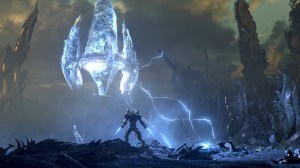
When the Tomb Raider reboot first released back in 2013, fans of the iconic Lara Croft were invited on a journey based on evolution. For veterans of the franchise, we know Croft as this badass, confident adventurer that can take on any challenge. The reboot shows a much different journey, a metamorphosis from a young adult into a weathered survivor with a thirst for knowledge.
Videos by ComicBook.com
I recently got to play the latest, and final, installment in this journey, Shadow of the Tomb Raider, for a few hours and immediately I was drawn into how much darker this Lara was from the previous two games. Where as in the first reboot she was scared, confused, and just finding her footing on how to survive: the hunted. In Rise of the Tomb Raider, we saw a more confident Lara that no longer strayed from the truth and instead faced it head on: the hunter. With Shadow of the Tomb Raider, we see a hardened Lara that shies away from no challenge with an almost tunnel vision for the truth – no matter who it hurts: the master.
When I spoke with the Narrative Director at Eidos Montreal, he told me that this third installment will be the apex and reveal that “defining moment” that made her who she is today. This journey brings in the more sordid natures of choice and the path she traveled, with many decisions that force her to confront her humanity and what she’s willing to sacrifice. He also mentioned that Shadow of the Tomb Raider is much more than “just raiding tombs,” it’s a journey of self-discovery and terrifying revelations.
Upon starting my time with the game, there was an immediate reaction to this “new” Lara. More confident, bordering ruthless: ready. Her obsessiveness with finding the “bad guy” is very much evident in this game with certain dialogue points that allow players to see this internal struggle. At several points during my time with the title, another character, Jonah, would mention that there are real life people to save, to help, but her focus remains fully on her task, on her obsession with Trinity.
The enemy, Dominguez, is a focus for her during my time with the demo though there was an interesting juxtaposition between her perception of him and some of his actions seen in-game. Whereas she spoke only of an ‘evil,’ there were many moments during the playthrough that he was compassionate, interactive, even with those unnassociated with him. To me, this furthered that dualism that is at the very core of Shadow of the Tomb Raider, challenging the player’s view of what’s “good” and what’s “evil.” The lines are blurred on both sides, both fighting for knowledge and power of that knowledge.
In addition to the game’s more psychological appeal, the actual gameplay itself was a perfect pairing with the overall theme. Shadow of the Tomb Raider is far more interactive than the previous two titles. From exploring underwater with this ever present threat of death, drowning, and an underlying feeling of drowning, to scaling alongside a vine-covered wall to control the flow of battle. It is very obvious that this Lara has found her footing and that is absolutely reflecting in the actual gameplay mechanics. She is no longer struggling to survive, to understand her surroundings – now, she is her surroundings, she’s in control.
I also spoke with the game’s lead designer, Heath Smith, and he said that though Lara’s journey is a much darker, inherently conflicted, story that she is very rarely actually alone in the game. The man’s voice heard in the reveal trailer, Jonah, plays a large part in keeping Lara rooted, keeps her from losing herself. The Narrative Director told me that he acts as her anchor in-game, to set her straight when her impulses cause more harm than good to those around her.
One game mechanic that I found absolutely enthralling is that this entire game is about her descent and ascension. Almost a rising phoenix effect and the gameplay mechanics such as her grapple and scaling absolutely reflected that. The leader designer mentioned that this was absolutely intentional in the name of immersion. The player is truly a part of this journey – it’s much more than a game and a closure to this arc in the series, it’s an experience that will challenge a player’s perception on what is “right” and what needs to be done “right now.”
The underwater aspect portrayed this feeling of immersion perfectly, often in terrifying ways. There was a moment when I was swimming that this giant eel that could be seen in the peripheral suddenly attacked and immediately, I felt real panic. I felt like I was drowning, trapped, and hopeless. To be able to force a player to feel that level of emotion at the start of the game is incredible, and a powerful testament to the level of care that went into the development of this game.
I would recommend those interested in this title play the first two first – it would make her evolution that much more impactful, though the game did do a wonderful job at recapping her journey and the developers told me that it’s not absolutely imperative to have played Shadow’s predecessors. Though they said it wasn’t mandatory, I couldn’t imagine playing this without prior knowledge of the overall framework, this is an incredible journey for this character with so many details hidden away in the narrative that add up to a much larger picture.
Shadow of the Tomb Raider is a much darker journey, one that I am thrilled to go on and seems to be a promising conclusion to a much younger Lara’s journey.








